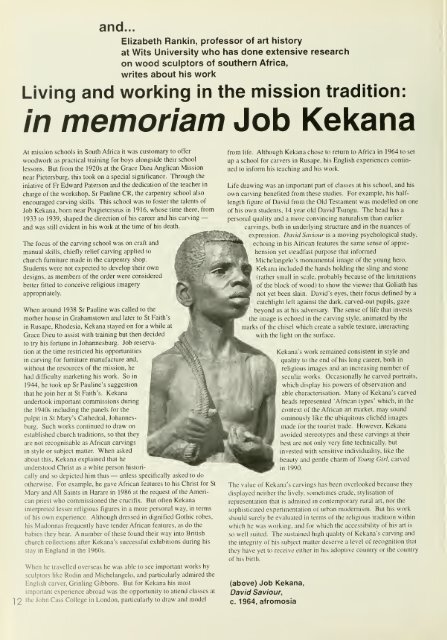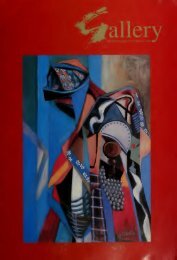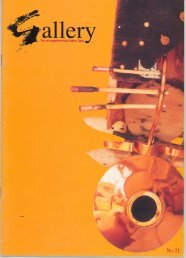Gallery : the art magazine from Gallery Delta
Gallery : the art magazine from Gallery Delta
Gallery : the art magazine from Gallery Delta
You also want an ePaper? Increase the reach of your titles
YUMPU automatically turns print PDFs into web optimized ePapers that Google loves.
] 2<br />
and...<br />
Elizabeth Rankin, professor of <strong>art</strong> history<br />
at Wits University who has done extensive research<br />
on wood sculptors of sou<strong>the</strong>rn Africa,<br />
writes about his work<br />
Living and working in <strong>the</strong> mission tradition:<br />
in memoriam Job Kekana<br />
At mission schools in South Africa it was customary to offer<br />
woodwork as practical training for boys alongside <strong>the</strong>ir school<br />
lessons. But <strong>from</strong> <strong>the</strong> 1920s at <strong>the</strong> Grace Dieu Anglican Mission<br />
near Pietersburg, this took on a special significance. Through <strong>the</strong><br />
iniative of Fr Edward Paterson and <strong>the</strong> dedication of <strong>the</strong> teacher in<br />
charge of <strong>the</strong> workshop, Sr Pauline CR, <strong>the</strong> carpentry school also<br />
encouraged carving skills. This school was to foster <strong>the</strong> talents of<br />
Job Kekana, bom near Potgietersrus in 1916, whose time <strong>the</strong>re, <strong>from</strong><br />
1933 to 1939, shaped <strong>the</strong> direction of his career and his carving —<br />
and was still evident in his work at <strong>the</strong> time of his death.<br />
The focus of <strong>the</strong> carving school was on craft and<br />
manual skills, chiefly relief carving applied to<br />
church furniture made in <strong>the</strong> carpentry shop.<br />
Students were not expected to develop <strong>the</strong>ir own<br />
designs, as members of <strong>the</strong> order were considered<br />
better fitted to conceive religious imagery<br />
appropriately.<br />
When around 1938 Sr Pauline was called to <strong>the</strong><br />
mo<strong>the</strong>r house in Grahamstown and later to St Faith's<br />
in Rusape, Rhodesia, Kekana stayed on for a while at<br />
Grace Dieu to assist with training but <strong>the</strong>n decided<br />
to try his fortune in Johannesburg. Job reserva-<br />
tion at <strong>the</strong> time restricted his opportunities<br />
in carving for furniture manufacture and,<br />
without <strong>the</strong> resources of <strong>the</strong> mission, he<br />
had difficulty marketing his work. So in<br />
1944, he took up Sr Pauline's suggestion<br />
that he join her at St Faith's. Kekana<br />
undertook important commissions during<br />
<strong>the</strong> 1940s including <strong>the</strong> panels for <strong>the</strong><br />
pulpit in St Mary's Ca<strong>the</strong>dral, Johannes-<br />
burg. Such works continued to draw on<br />
established church traditions, so that <strong>the</strong>y<br />
are not recognisable as African carvings<br />
in style or subject matter. When asked<br />
about this, Kekana explained that he<br />
understood Christ as a white person histori<br />
cally and so depicted him thus — unless specifically asked to do<br />
o<strong>the</strong>rwise. For example, he gave African features to his Christ for St<br />
Mary and All Saints in Harare in 1986 at <strong>the</strong> request of <strong>the</strong> American<br />
priest who commissioned <strong>the</strong> crucifix. But often Kekana<br />
interpreted lesser religious figures in a more personal way, in terms<br />
of his own experience. Although dressed in dignified Gothic robes,<br />
his Madonnas frequently have tender African features, as do <strong>the</strong><br />
babies <strong>the</strong>y bear. A number of <strong>the</strong>se found <strong>the</strong>ir way into British<br />
church collections after Kekana's successful exhibitions during his<br />
stay in England in <strong>the</strong> 1960s.<br />
When he travelled overseas he was able to see important works by<br />
sculptors like Rodin and Michelangelo, and p<strong>art</strong>iculariy admired <strong>the</strong><br />
English carver, Grinling Gibbons. But for Kekana his most<br />
important experience abroad was <strong>the</strong> opportunity to attend classes at<br />
<strong>the</strong> John Cass College in London, p<strong>art</strong>icularly to draw and model<br />
<strong>from</strong> life. Although Kekana chose to return to Africa in 1964 to set<br />
up a school for carvers in Rusape, his English experiences contin-<br />
ued to inform his teaching and his work.<br />
Life drawing was an important p<strong>art</strong> of classes at his school, and his<br />
own carving benefited <strong>from</strong> <strong>the</strong>se studies. For example, his half-<br />
length figure of David <strong>from</strong> <strong>the</strong> Old Testament was modelled on one<br />
of his own students, 14 year old David Tsungu. The head has a<br />
personal quality and a more convincing naturalism than earlier<br />
carvings, both in underiying structure and in <strong>the</strong> nuances of<br />
expression. David Saviour is a moving psychological study,<br />
echoing in his African features <strong>the</strong> same sense of appre-<br />
hension yet steadfast purpose that informed<br />
Michelangelo's monumental image of <strong>the</strong> young hero.<br />
Kekana included <strong>the</strong> hands holding <strong>the</strong> sling and stone<br />
(ra<strong>the</strong>r small in scale, probably because of <strong>the</strong> limitations<br />
of <strong>the</strong> block of wood) to show <strong>the</strong> viewer that Goliath has<br />
not yet been slain. David's eyes, <strong>the</strong>ir focus defined by a<br />
catchlight left against <strong>the</strong> dark, carved-out pupils, gaze<br />
beyond us at his adversary. The sense of life that invests<br />
<strong>the</strong> image is echoed in <strong>the</strong> carving style, animated by <strong>the</strong><br />
marks of <strong>the</strong> chisel which create a subtle texture, interacting<br />
with <strong>the</strong> light on <strong>the</strong> surface.<br />
Kekana's work remained consistent in style and<br />
quality to <strong>the</strong> end of his long career, both in<br />
religious images and an increasing number of<br />
secular works. Occasionally he carved portraits,<br />
which display his powers of observation and<br />
able characterisation. Many of Kekana's carved<br />
heads represented "African types' which, in <strong>the</strong><br />
context of <strong>the</strong> Afncan <strong>art</strong> market, may sound<br />
ominously like <strong>the</strong> ubiquitous cliched images<br />
made for <strong>the</strong> tourist trade. However, Kekana<br />
avoided stereotypes and <strong>the</strong>se carvings at <strong>the</strong>ir<br />
best are not only very fine technically, but<br />
invested with sensitive individuality, like <strong>the</strong><br />
beauty and gentle charm of Young Girl, carved<br />
in 1990.<br />
The value of Kekana's carvings has been overiooked because <strong>the</strong>y<br />
displayed nei<strong>the</strong>r <strong>the</strong> lively, sometimes crude, stylisation of<br />
representation that is admired in contemporary rural <strong>art</strong>. nor <strong>the</strong><br />
sophisticated experimentation of urban modernism. But his work<br />
should surely be evaluated in terms of <strong>the</strong> religious tradition within<br />
which he was working, and for which <strong>the</strong> accessibility of his <strong>art</strong> is<br />
so well suited. The sustained high quality of Kekana's carving and<br />
<strong>the</strong> integrity of his subject mailer deserve a level of recognition that<br />
<strong>the</strong>y have yet to receive ei<strong>the</strong>r in his adoptive country or <strong>the</strong> country<br />
of his birth.<br />
(above) Job Kekana,<br />
David Saviour,<br />
c. 1964, a<strong>from</strong>osia







